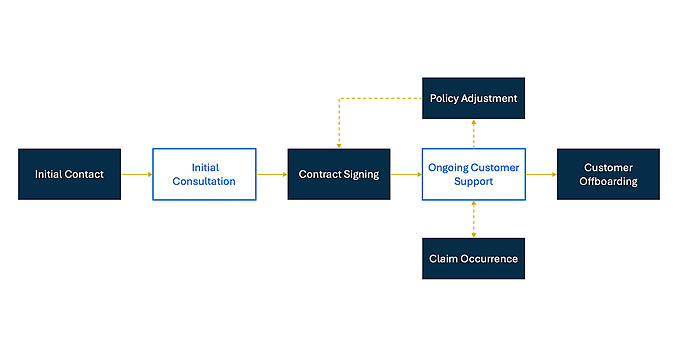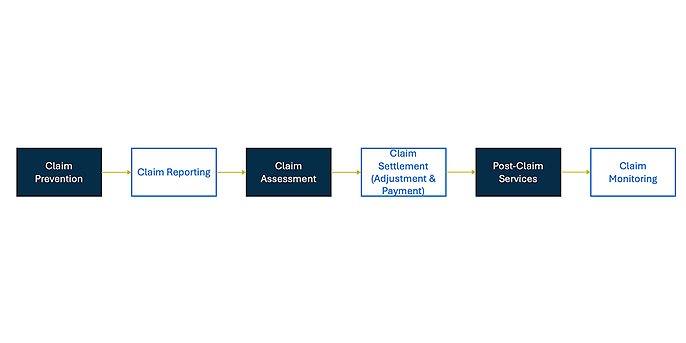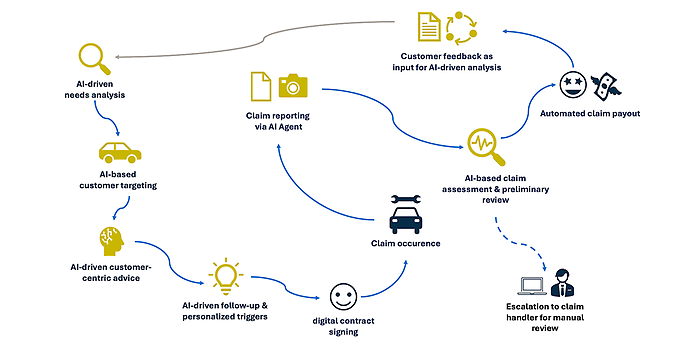4. June 2025 By Sebastian Geißinger
Artificial intelligence in the insurance industry
From trend to strategic value driver
Artificial intelligence (AI) has long been a reality and is becoming a success factor in the field of competition, customer expectations and efficiency. But how can abstract technologies be turned into tangible added value? And what if not only processes could become more efficient, but customer relationships could also become more personal and sustainable? The key question is therefore: Where exactly does the greatest potential lie along the value chain, and which specific technologies and use cases can actually expand customer value in the long term?
In my master's thesis, I asked myself this question and took an in-depth look at how primary insurers can use AI to expand their current value proposition to customers. This blog post offers decision-makers and executives practical insights into the research findings on the key value-adding areas of consulting, sales, service and claims management.
Value is created at the moment of truth: where insurers create real customer value
Insurance accompanies us throughout our lives, mostly unnoticed in the background, but very close at hand in crucial moments. When we want to protect ourselves or when damage occurs, it becomes clear that trust and reliability are what really matter. This is precisely where the true value of insurance lies. Because value creation arises where insurers deliver on their promise: in the event of a claim.
At the same time, claims represent a central interface between sales, consulting and service management. These areas accompany customers from the initial contact through the initial consultation and contract conclusion to ongoing support and advice (see Figure 1).
Insurance is based on trust, and this trust is built in particular through a targeted and personal approach. Those who understand the needs of their customers can not only offer tailor-made solutions, but also develop a long-term relationship from a single contact.

Abbildung 1: Teilprozessschritte Vertrieb, Beratung und Servicemanagement
Claims management shows whether a contractual promise translates into concrete support. The process steps – as shown in Figure 2 – from claims prevention to claims acceptance, claims assessment, claims settlement and claims controlling determine how customer-oriented an insurer is. Is the response quick? Is information provided transparently? Is the treatment fair? These questions shape customers' perceptions and make the difference between a mere provider and a trusted partner.

Abbildung 2: Teilprozessschritte Schadenmanagement
Consulting, sales, service and claims management are not peripheral areas. They are at the heart of customer perception. This is where what policyholders really feel comes into play: support, security and proximity. And this is precisely where the true core of value creation lies.
Between expectations and efficiency: where insurers need to start today
How can genuine customer experiences not only be preserved in the digital world, but also expanded in a targeted manner? This is precisely where AI unfolds its potential. In the data-driven world of insurance, it has long been part of everyday operations – especially in consulting, sales, service and claims management.
These areas offer ideal conditions: they are close to customers and shape trust and satisfaction. At the same time, many processes are rule-based, but also individual in parts, and are therefore prone to errors and abuse. These are ideal conditions for the targeted use of AI.
AI is proving its worth in consulting, sales and service management. Predictive analytics models identify customer needs at an early stage, chatbots support and advise customers or navigate quickly, efficiently and around the clock through application processes for standardised insurance products.
In claims management, for example, AI is already speeding up processes through image analysis, speech processing and pattern recognition. The result: shorter processing times, more accurate payments, early detection of fraud attempts and, above all, a smooth experience for customers at the moment of truth.
The potential is enormous, but the really exciting question is: Where exactly along the respective value chains does AI offer the greatest potential for substantially expanding the existing value proposition?
To get to the bottom of this question, I spoke specifically with industry experts as part of my research and systematically evaluated their perspectives along the defined value creation areas. The group of experts surveyed consists of strategic consultants from the insurance and IT sectors and predominantly executives from German primary insurance and software development companies.
Sales, consulting and service management
In sales, consulting and service management, the experts surveyed see considerable potential for the targeted use of AI, particularly in the process steps of establishing contact, initial consulting and ongoing support/consulting.
In establishing contact, AI enables targeted, personalised customer engagement via preferred channels through pattern recognition and predictive analytics. This allows customer clusters to be identified so that appropriate content can be placed at the right time (e.g. during discount campaigns). Virtual assistants and AI-supported agents use speech processing to increase efficiency and minimise sources of error – for example, by extracting unstructured data from incoming documents to support administrative tasks.
AI also offers clear added value in initial consultations. Generative AI can use speech-to-text technologies to automatically create conversation logs, reducing administrative effort and creating more space for personal consultation. At the same time, recommendation engines support individual product recommendations, for example in cross-selling and upselling measures or through next-best-action suggestions for individual customers. In the event of dissatisfaction, large language models provide support with empathetic and individually formulated email responses, thus contributing to a positive service experience right from the start of the customer relationship.
AI is used in ongoing support and consulting through voice and speech recognition, natural language processing and facial recognition. This allows callers to be automatically identified and linked to existing customer data, giving consultants an immediate and comprehensive overview. Voice pattern analysis also supports the automated generation of suitable consulting suggestions. Facial recognition can also detect the emotional state of customers and enable situationally appropriate conversation management. In addition, online machine learning processes continuously analyse customer feedback in order to continuously optimise product offerings on a data-driven basis based on successful contract conclusions.
This results in an interactive and customer-focused customer journey with a significantly enhanced service experience. The added value is particularly evident where individual attention, continuous interaction and data-based advice are required.
Claims management
The extended value proposition of AI is also particularly tangible in claims management. According to the experts surveyed, the process steps of claims prevention, claims acceptance and claims assessment offer relevant potential for application.
In claims prevention, AI technologies such as pattern recognition, predictive analytics, and image and video analysis open up new possibilities. For example, satellite images can be automatically evaluated to identify endangered property – such as in potential storm or flood zones – at an early stage. This allows targeted preventive measures to be taken. In addition, customer cluster analyses enable the identification of risk-related behaviour patterns, for example in the automotive sector, where individual telematics tariffs can be integrated into insurance models as preventive add-on modules. This creates clear added value for insurers and customers, in particular through risk-adequate and model-based premium structuring.
AI also plays to its strengths in claims handling. Voice bots and speech-to-text processes automatically transform telephone claims into structured claims files. At the same time, natural language processing ensures that content from emails or forms is automatically recognised, extracted and transferred to the relevant systems. This speeds up processing, minimises queries and improves the overall service experience.
Experts see particular potential in image and video analysis and pattern recognition in the context of claims assessment. Automated classification and object detection algorithms can be used, for example, to accurately identify and assess damage to vehicles or buildings based on submitted images. Vision systems such as cameras or 3D scanners also enable fully automated claims assessment, including the determination of the cause of the accident. In addition, the analysis of patterns from previous claims enables targeted fraud detection. Generative AI also supports automated customer communication, such as for appointment scheduling or feedback during the claims process, significantly increasing both efficiency and service quality.
The analysis shows that AI has the greatest impact in claims management where large amounts of data, standardisable processes and direct customer interfaces come together. The extended value proposition ranges from higher service quality and savings in contribution costs to personalised customer communication and risk minimisation and avoidance.
Claims management reimagined – with Generative AI
From automated claims recording to intelligent communication: With GenAI solutions from adesso, insurers can increase efficiency, customer satisfaction and innovation. Discover how modern AI can transform your claims management.
Recommended action: Start implementing AI with clear priorities
Insurance companies should start using AI in areas where high customer expectations meet critical business areas. According to industry experts, the greatest potential lies in the areas of loss prevention, claims assessment, initial contact, and ongoing support and advice. This is precisely where tangible added value for customers is created – through risk minimisation, savings in contribution costs, personalised customer communication and an enhanced service experience.
It is important to note that the success of AI projects depends largely on consistently focusing on customer benefits. Technology must not be an end in itself – it must meet and exceed customer expectations. In addition to technical feasibility, insurers should therefore also pay attention to data availability, internal capabilities and a clear customer benefit perspective.
Those who start today and create measurable added value are laying the foundation for a long-term, customer-centric AI strategy. In this way, AI becomes not only a strategic value driver, but also a real differentiator in the competitive environment.

Our offer
Would you like to use generative AI in your insurance company? adesso can help you with everything from identifying relevant use cases and developing customised solutions to integrating them into existing processes. With our in-depth industry knowledge and technological excellence, we will guide you on your journey to the AI-powered insurance of tomorrow.

